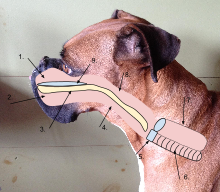Can a boxer win in working class?
Pure breeds are looked upon very critically these days. Sometimes for good reasons, but at the moment is seems to be standard procedure for the anti pure bred lobby to grab every subject regardless the health of the dogs. Anyone posting a photo of a pure bred dog on Social Media with a sad story attached to it is bound to have dozens of responses from the canine-loving society. Especially like-minded people will respond, and objectivity or knowledge of the subject seem completely unnecessary. Opinions are all readily pulled out: pure breds and show people are all scum and mutts all turn very, very old, obviously without ever visiting a vet.
Well, of course the latter could well be true. But is does seem essential the things written about pure bred dogs – and crossbreeds – at least contain some truth. An article about the winning dog in the working class of last weekends’ Winner Show caught Dogzine’s attention for that reason.
A good looking boxer (Capo Di Tutti Capi Bounciparade) won the class, which was judged by mr Peter van Montfoort. The picture and a video was published online with a comment saying: “It is remarkable a boxer without a muzzle won this class” and “These days the boxer is a weak rehash (of the boxer as it was 100 years ago, AH) with disorders of back, hips and heart and tormented by breathlessness and overheating”.
Attack
 The owner of the dog, Caroline Moulds from Scotland, told Dogzine she is not amused by this negative attention for her dog. “This is an attack on my dog. These dogs are fit for purpose or would be unable to pass VZH or IPO-1 exams. My dog has never had a single day of breathing issues and in fact is longer than this post suggest on his muzzle (…)It's a disgusting attack on our breed and to use my dog as a target when his nose is clearly correct, is ludicrous. This group, asks for donations but does not animal work. They really are the money factor.”
The owner of the dog, Caroline Moulds from Scotland, told Dogzine she is not amused by this negative attention for her dog. “This is an attack on my dog. These dogs are fit for purpose or would be unable to pass VZH or IPO-1 exams. My dog has never had a single day of breathing issues and in fact is longer than this post suggest on his muzzle (…)It's a disgusting attack on our breed and to use my dog as a target when his nose is clearly correct, is ludicrous. This group, asks for donations but does not animal work. They really are the money factor.”
Besides, this dog would never have made first place with this judge if it didn’t suffice, Moulds says, because this judge has a lot of experience with boxers.
Peter van Montfoort, judge on this Winner Show, confirms the statements Moulds made: “A working dog of this breed needs to be able to run alongside the bicycle for 20 kilometers, in the so-called UV-test (endurance test) breathing problems are no option then. This dog is fit for its function and has proven it by entering in this class. There are plenty of German Shepherds out there with long muzzles that could never make those 20 kilometers”.
Healthy
Mould considers the article an attack on the boxer breed and is not happy about the publishing (without permission) of pictures of her dog. “This dog is well known in the world and they have made uproar because he is one of the best examples of modern boxer we have. He has a clear heart, clear hips and clear spondylosis. He is very healthy!” The dog is considered a very good example of the breed since the proportions of the head and muzzle are not overdone anywhere.
Obviously both judges and owners will speak positively about their dog and and breed so let’s take an objective look and see what this so much feared brachiocephalic obstructive syndrome (BOS) is all about, and let’s look at what a working class dog actually has to be.
Working class
On the Winner show we see in the final judging awards for classes of youngest and oldest dogs, but also for working dogs, in a special class also known as utility. These classes exist in every breed as separate classes within the breed, if it has that option (for example companion dogs do not).
To qualify for the working class a dog has to reach a certain level in a sport fitting with its breed. The working class thus had hunting dogs entered that had qualified in field trials and dachshunds that had qualified in bloodtracking, which is a specific type of tracking. And a number of dogs were entered from the guarding group, dogs that have to qualify in IPO (Internatinale Prüfungs Ordnung). This is a sport for protection work in dogs. IPO contains protectionwork/bitework, tracking and obedience. In bitework the dog has to find the “crook”, bark and stop him. In the tests it is not a crook but a helper in a protected suit called decoy, who is barked at and stopped. He will be accompanied by the dog while the decoy is walking forward. The decoy may try to escape and the dog then has to interact and stop him.
 To join IPO a dog first has to qualify for a diploma to show he is fit and reliable in all circumstances. It contains obedience and a number of practical tests. All and all this is a fairly severe program that takes a lot of training for the owner but definitely for the dog. It is quite fair and understandable that these achievements are rewarded by being allowed in a special class: it means the dog can be distinguished from the rest of its breed by its sporting achievements. Entering in this class means the dog has proven to be able to do all it was originally bred for.
To join IPO a dog first has to qualify for a diploma to show he is fit and reliable in all circumstances. It contains obedience and a number of practical tests. All and all this is a fairly severe program that takes a lot of training for the owner but definitely for the dog. It is quite fair and understandable that these achievements are rewarded by being allowed in a special class: it means the dog can be distinguished from the rest of its breed by its sporting achievements. Entering in this class means the dog has proven to be able to do all it was originally bred for.
Weak rehash?
On the Winner 2016 the final judging of the Working Class was won by the boxer mentioned in this article. A dog that has proven its abilities because if it didn’t, it would not be entered in this class. And yes, these achievements are checked. Therefore it seems rather odd that another article attacked this dog by saying: “By origin the boxer is a watchdog and fighting dog that was used in Germany for hunting wild boar and bear. These days the boxer is a weak rehash (of the boxer as it was 100 years ago, AH) with disorders of back, hips and heart and tormented by breathlessness and overheating.”
If this dog were to qualify for “a weak rehash” then how could it possibly enter in this class? Looking at the dog, weak isn’t the first word to springs to mind by the way: an athletic and muscular dog, with easy and supple gait, a dog that is clearly full of energy.
Soft tissue
The author states that the shorter a muzzle is, the larger the chances are for the so-called brachiocephalic obstructive syndrome. That may be true, but only to a certain extend. The brachiocephalic obstructive syndrome is partly caused by a shortened muzzle. The main cause lies in an overload of soft tissue. When there is too much soft tissue – ie skin - in one place, there will also be too much in other places. Considering this, it isn’t so strange for a breed with a relatively short muzzle and lots of wrinkles like for example an English Bulldog, to have breathing problems.
But in a sporting dog like a boxer breathing is one of the things all breeders keep a close eye on. Simply because a good sporting dog will not be able to achieve anything if it cannot breathe properly.
The undershot lower jaw finds its origin in the ability to (bull)bite and still be able to breathe. Obviously bullbiting isn’t something boxers do nowadays, but protectionwork it still does on a regular basis. So yes, a boxers’ nose is shorter then in many other breeds but it very rarely causes breathing problems. And for a dog entering in the Dutch working class that assumption indeed is ludicrous.
They know nothing
Muolds, the owner of the dog, isn’t very worried about negativity:
“I have more important things to do than worry about people who know nothing and want only a mixed race world of dogs with attitudes and bullying tactics seen more too often on social media.”





